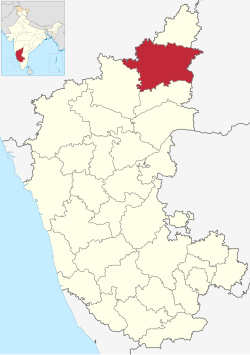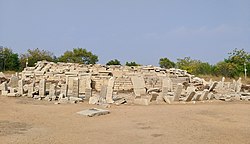This article has multiple issues. Please help improve it or discuss these issues on the talk page. (Learn how and when to remove these messages)
|
Kalaburagi district, formerly known as Gulbarga district,[2] is one of the 31 districts of Karnataka state in southern India. Kalaburagi city is the administrative headquarters of the district.[3] The district is the headquarters of Kalaburagi division.
Kalaburagi district
Gulbarga district | |
|---|---|
Clockwise from top-left: Kalaburagi Fort, Suryanarayana Temple in Kalgi, Panchlingeshwara Temple near Sedam, Ruins in Sannati, Mosque in Gulbarga city | |
| Nickname: Land of Toor Dal | |
 Location in Karnataka | |
| Coordinates: 17°17′N 76°49′E / 17.283°N 76.817°E | |
| Country | |
| State | Karnataka |
| Region | Kalyana-Karnataka |
| Division | Kalaburagi Division |
| Headquarters | Kalaburagi |
| Talukas | Aland, Shahabad, Kamalapur, Chitapur, Afzalpur, Jevargi, Yedrami, Kalaburagi, Kalgi, Chincholi, Sedam, |
| Government | |
| • Type | Karnataka state Government |
| • Body | Karnataka Legislative Assembly |
| • Deputy Commissioner | Fouzia Taranum, IAS[1] |
| Area † | |
• Total | 10,951 km2 (4,228 sq mi) |
| Elevation | 454 m (1,490 ft) |
| Population (2011)† | |
• Total | 2,566,326 |
| • Density | 230/km2 (610/sq mi) |
| Language | |
| • Official | Kannada, |
| Time zone | UTC+5:30 (IST) |
| PIN | 585101
585102 585103 |
| Telephone code | 91 8472 |
| Vehicle registration | KA-32 |
| No. of taluks | 11 |
| Lok Sabha constituency | Kalaburagi (Lok Sabha constituency) |
| Precipitation | 777 millimetres (30.6 in) |
| Avg. summer temperature | 42 °C (108 °F) |
| Avg. winter temperature | 26 °C (79 °F) |
| Website | kalaburagi |
| †website | |
This district is situated in north Karnataka between 76°.04' and 77°.42 east longitude, and 17°.12' and 17°.46' north latitude, covering an area of 10,951 km2. This district is bounded on the west by Bijapur district and Solapur district of Maharashtra state, on the north by Bidar district and Osmanabad district of Maharashtra state, on the south by Yadgir district, and on the east by Sangareddy and Vikarabad districts of Telangana state.
History
editThe name of the area in Kannada is Kala-buragi, meaning "stony land." In the 6th century CE, the district was under the control of the Chalukyas. The Rashtrakutas briefly conquered the area, but were driven out by the Chalukyas who ruled the area for the next two centuries. The Kalachuris then conquered the area and ruled it until 12th century, when they were driven out by the Yadavas. Afterwards it was ruled by the Kakatiyas, who ruled until 1324, when their kingdom fell to the Delhi Sultanate. The ambitions of the local governors led to the formation of the Bahmani sultanate, who made Kalaburagi their capital. The Bahmanis eventually fell and left in their place a patchwork of 5 Deccan Sultanates. Kalaburagi was ruled by the Bidar sultanate until its annexation by Bijapur in 1619. Soon the district would become part of the Mughal Empire, but the Asaf Jahi governors of the Deccan later broke away and formed their own Hyderabad State, and Kalaburagi was ruled by them. This state became a princely state of British India, until its annexation by India in 1948. Afterwards, Kalaburagi, along with Bidar and Raichur, became part of Karnataka and were known as the Kalyana-Karnataka region. Since this time, this region has continuously been lagging the rest of the state in social indicators and is considered the most backward region of Karnataka.[4]
Economy
editIn 2006 the Ministry of Panchayati Raj named Kalaburagi one of the country's 243 most backward districts (out of a total of 640).[5] It is one of the five districts in Karnataka currently receiving funds from the Backward Regions Grant Fund Programme (BRGF).[5]
Places of interest
editHistorical places
edit- Sannati, a small village, located on the banks of the Bhima River in Chitapur taluk is known for its Ashokan edicts, Buddhist stupa and sole surviving image of Emperor Ashoka (r. 274–232 BC) himself.[6]
- Manyakheta, a village located on the banks of the Kagina river in Sedam taluk was the Capital city of the Rashtrakuta dynasty. This village is 40 km southeast to the District Headquarters Kalaburagi and 18 km west to the Taluk Headquarters Sedam.
- Kalaburagi Fort built in 1347 Kalaburagi's old moated fort is in a much deteriorated state, but it has a number of interesting buildings inside, including the Jama Masjid, reputed to have been built by a Moorish architect during the late 13th or early 14th century who imitated the great mosque in Cordoba, Spain.[7] The mosque is unique in India, with a huge dome covering the whole area, four smaller ones at the corners, and 75 smaller still all the way around. The fort itself has 15 towers. Kalaburagi also has a number of imposing tombs (Haft Gumbaz) of Bahmani kings.
Geography
editKalaburagi is situated in Deccan Plateau located at 17°20′N 76°50′E / 17.33°N 76.83°E[8] and the general elevation ranges from 300 to 750 meters above mean sea level. The main river is the Bhima.
Subdivisions
editKalaburagi district presently comprises the following 11 talukas after the separation of Yadgir district from it.[9]
Demographics
edit| Year | Pop. | ±% p.a. |
|---|---|---|
| 1901 | 586,760 | — |
| 1911 | 640,851 | +0.89% |
| 1921 | 589,958 | −0.82% |
| 1931 | 658,151 | +1.10% |
| 1941 | 704,139 | +0.68% |
| 1951 | 806,394 | +1.37% |
| 1961 | 963,619 | +1.80% |
| 1971 | 1,208,007 | +2.29% |
| 1981 | 1,442,258 | +1.79% |
| 1991 | 1,786,138 | +2.16% |
| 2001 | 2,174,742 | +1.99% |
| 2011 | 2,566,326 | +1.67% |
| source:[10] | ||
According to the 2011 census Kalaburagi district has a population of 2,566,326,[12] roughly equal to the nation of Kuwait[13] or the US state of Nevada.[14] This gives it a ranking of 162nd in India (out of a total of 640).[12] The district has a population density of 233 inhabitants per square kilometre (600/sq mi).[12] Its population growth rate over the decade 2001-2011 was 17.94%.[12] Gulbarga has a sex ratio of 971 females for every 1000 males,[12] and a literacy rate of 64.85%. 32.56% of the population lives in urban areas. Scheduled Castes and Scheduled Tribes make up 25.28% and 2.54% of the population respectively.[12]
Languages
editAccording to the 2011 census, 65.70% of the population spoke Kannada, 18.15% Urdu, 7.09% Lambadi, 4.08% Telugu, 2.47% Marathi and 2.05% Hindi as their first language.[16]
See also
editReferences
edit- ^ "Several IAS officers transferred in Karnataka". The New Indian Express. 20 June 2023. Retrieved 21 June 2023.
- ^ "Gulbarga city name changed". indiatoday.intoday.in. Retrieved 2 May 2016.
- ^ "City of tombs and domes". The Hindu. Karnataka, India. 4 April 2011. Archived from the original on 10 April 2011.
- ^ "History | Kalaburagi District | Government of Karnataka | India". Retrieved 25 October 2020.
- ^ a b Ministry of Panchayati Raj (8 September 2009). "A Note on the Backward Regions Grant Fund Programme" (PDF). National Institute of Rural Development. Archived from the original (PDF) on 5 April 2012. Retrieved 27 September 2011.
- ^ "When I met Emperor Ashoka in Sannathi". Yahoo. Archived from the original on 27 April 2012. Retrieved 21 April 2012.
- ^ "Friday Mosque of Gulbarga". Archived from the original on 20 November 2010. Retrieved 17 June 2010.
- ^ "Maps, Weather, and Airports for Gulbarga, India". www.fallingrain.com.
- ^ "Yadgir district from Oct 31". 27 August 2009.
- ^ Decadal Variation In Population Since 1901
- ^ "Table C-01 Population by Religion: Karnataka". censusindia.gov.in. Registrar General and Census Commissioner of India. 2011.
- ^ a b c d e f "District Census Handbook: Gulbarga" (PDF). censusindia.gov.in. Registrar General and Census Commissioner of India. 2011.
- ^ US Directorate of Intelligence. "Country Comparison:Population". Archived from the original on 13 June 2007. Retrieved 1 October 2011.
Kuwait 2,595,62
- ^ "2010 Resident Population Data". U. S. Census Bureau. Retrieved 30 September 2011.
Nevada 2,700,551
- ^ "Table C-16 Population by Mother Tongue: Karnataka". Census of India. Registrar General and Census Commissioner of India. Retrieved 23 April 2022.
- ^ "Table C-16 Population by Mother Tongue: Karnataka". www.censusindia.gov.in. Registrar General and Census Commissioner of India.





